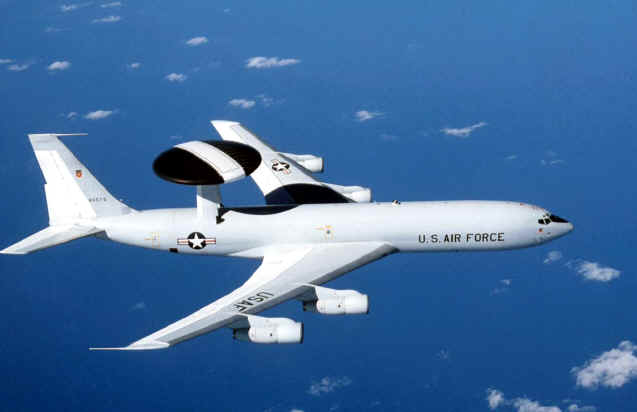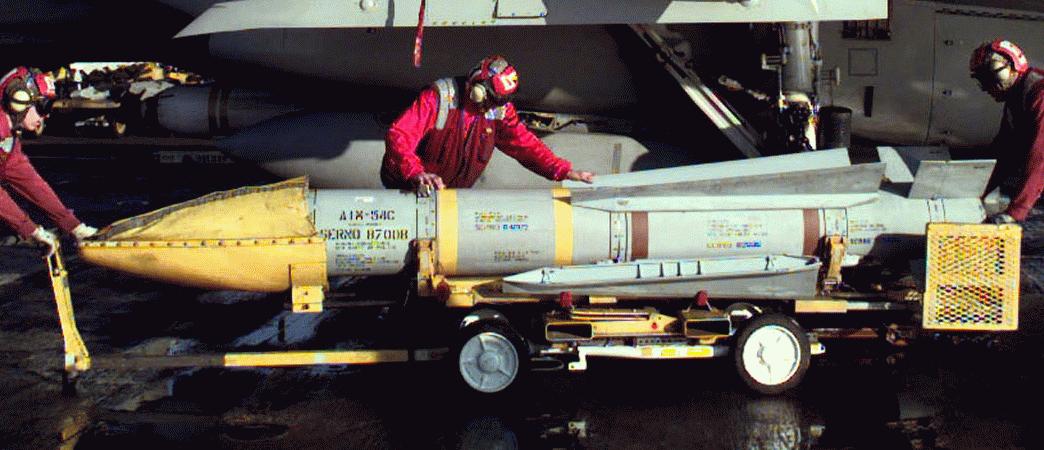 The advent of powerful radar held aloft by a
long-range transport planes to direct fighter aircraft made its debut
toward the end of the Vietnam war and in the
1971 Indo-Pakistani war. Unlike a ground radar, which misses large areas due to the curvature of the
Earth,
airborne radar
"looks
down." The US Air Force E-3 AWACS (right) has a
huge radar dome mounted atop a 707 jet that can track all air traffic out to 200 miles. The AWACS directs fighters toward enemy threats where
they
shoot down enemy bogeys.
The advent of powerful radar held aloft by a
long-range transport planes to direct fighter aircraft made its debut
toward the end of the Vietnam war and in the
1971 Indo-Pakistani war. Unlike a ground radar, which misses large areas due to the curvature of the
Earth,
airborne radar
"looks
down." The US Air Force E-3 AWACS (right) has a
huge radar dome mounted atop a 707 jet that can track all air traffic out to 200 miles. The AWACS directs fighters toward enemy threats where
they
shoot down enemy bogeys.
These aircraft can track targets in all directions, whereas a fighter aircraft's nose mounted radar only "sees" whatever is toward its front. As a result, they often maneuver to "paint the sky" ahead of them in search of targets. Their range is less than 100 miles, although newer AESA radar may double that range. The basics of airborne radar is the bigger the better, so large airborne radar aircraft will always see fighters before fighters can find them. Surprisingly, airborne radar aircraft have never been armed. Since the US Air Force and the Navy have missiles that can fly hundreds of miles, there is no reason why AWACS and Hawkeyes cannot carry weapons.
 The big AIM-54
Phoenix anti-aircraft missile (left) was developed in the 1970s by the US Navy and
fielded for 30 years for use by the F-14 Tomcat. It had an impressive range of 100
miles, although it was never proven in combat by the US Navy. The Iranian
Air Force used Phoenix missiles during its war with Iraq and scored many
hits. The first time it was used successfully was on September 13, 1980
shooting down an Iraqi MIG-23, and the last time was on March 22, 1988 shooting
down a MiG-25. On several occasions, Iran's F-14s achieved multiple kills when
they fired volleys of Phoenix missiles at planes flying in tight
formation. The largest number of such kills was achieved on January 7,
1981 when missiles destroyed three Iraqi MiG-23s and damaged a fourth. The
US Navy was developing a newer version in
the 1990s, but that was canceled as the Cold War ended. The ageing Phoenix
was retired in 2004, so today's air-to-air missile range is limited to 20-90 miles.
The big AIM-54
Phoenix anti-aircraft missile (left) was developed in the 1970s by the US Navy and
fielded for 30 years for use by the F-14 Tomcat. It had an impressive range of 100
miles, although it was never proven in combat by the US Navy. The Iranian
Air Force used Phoenix missiles during its war with Iraq and scored many
hits. The first time it was used successfully was on September 13, 1980
shooting down an Iraqi MIG-23, and the last time was on March 22, 1988 shooting
down a MiG-25. On several occasions, Iran's F-14s achieved multiple kills when
they fired volleys of Phoenix missiles at planes flying in tight
formation. The largest number of such kills was achieved on January 7,
1981 when missiles destroyed three Iraqi MiG-23s and damaged a fourth. The
US Navy was developing a newer version in
the 1990s, but that was canceled as the Cold War ended. The ageing Phoenix
was retired in 2004, so today's air-to-air missile range is limited to 20-90 miles.
Fighter pilots never liked the idea of firing weaponry beyond visual range because their training and culture is focused on manly dog fighting. Nevertheless, it seems obvious that long-range radar-guided Phoenix type missiles are valuable to large airborne radar aircraft. Newer versions have even more range, accuracy, and maneuverability. They may also have internal radar like AMRAAM or an infrared sensor like Sidewinder for terminal guidance, to lock-on and pursue a target once distant airborne radar guidance has shown the way. Should one miss its target, the computerized radar system from the distant airborne radar can maneuver it for another engagement, perhaps with input from a human controller.
Another option is a two-stage Theater-Wide Air-to-Air Missiles (TWAAM) with a range of 1000 miles. The first stage is a cruise missile that carries a second-stage air-to-air missile with its own guidance system, like AMRAAM or Sidewinder. The cruise missile is guided by distant airborne radar or a human controller until its air-to-air missile warhead detects a target, detaches from the cruise missile and fires to pursue. Another cruise missile version may have a nose pod with several smaller short-range Stinger infrared missiles, like the Navy's Rolling Airframe Missile pod. TWAAMs will be expensive, but they target $100 million aircraft.
The long-range of TWAAMs allow them to fly long, looping profiles to attack a fighter from the top, side, or rear, where a fighter's radar system cannot detect it inbound. Remember that a fighter aircraft on patrol cruises no faster than a jumbo jet. Therefore, fighters may be attacked by TWAAMs with no clue of where they originated. Their overall affect on air combat is uncertain, but at least they provide a self-defense capability for airborne radar aircraft, and in the case of E-2D Hawkeyes, a second-line of fleet defense from attacking aircraft. Most likely, TWAAMs and AMRAAMs fired from larger aircraft will serve as the first volley in any major air engagement, forcing enemy fighters to break formation and flee while friendly fighters close and take advantage of the chaos.
©2015 www.G2mil.com